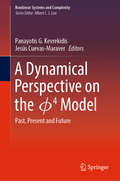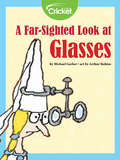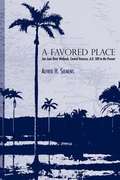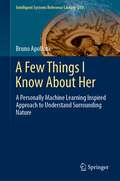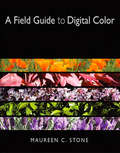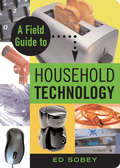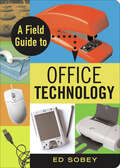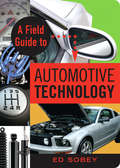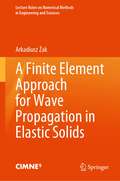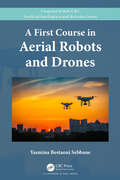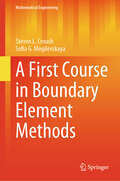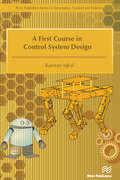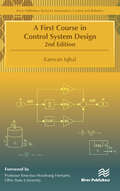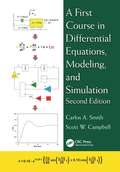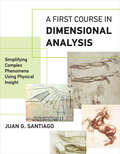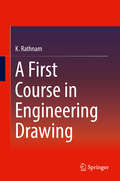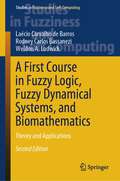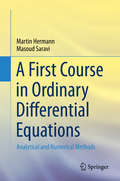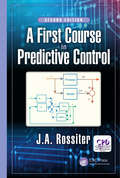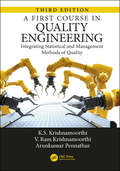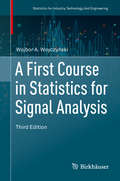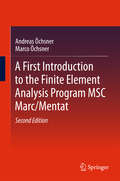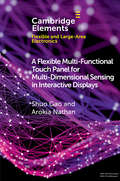- Table View
- List View
A Dynamical Perspective on the ɸ4 Model: Past, Present and Future (Nonlinear Systems and Complexity #26)
by Jesús Cuevas-Maraver Panayotis G. KevrekidisThis book presents a careful selection of the most important developments of the \phi^4 model, offering a judicious summary of this model with a view to future prospects and the challenges ahead. Over the past four decades, the \phi^4 model has been the basis for a broad array of developments in the physics and mathematics of nonlinear waves. From kinks to breathers, from continuum media to discrete lattices, from collisions of solitary waves to spectral properties, and from deterministic to stochastic models of \phi^4 (and \phi^6, \phi^8, \phi^12 variants more recently), this dynamical model has served as an excellent test bed for formulating and testing the ideas of nonlinear science and solitary waves.
A Far-Sighted Look at Glasses
by Michael GerberHave you ever wondered where glasses came from? This comic takes a fun look at the invention of glasses starting with the Greeks and Romans. Then it looks at attempts by the Spanish, Chinese, French, and even inventor Ben Franklin to improve the design.
A Farm Through Time
by Angela Wilkes Eric ThomasThis is the story of a farm and of its place in a changing landscape, from the Middle Ages to the present day. Following the rhythm of the seasons, it shows generations of farmworkers carrying out their daily tasks, ploughing and sowing, harvesting and haymaking. The book traces the development of the farm from a 9th century small-holding, rented from the local lord of the manor, to a large, mechanised farm of the 21st century. Eric Thomas' evocative illustrations capture the atmosphere of a rural idyll, showing farming communities working on the land, while liftable flaps open to reveal activities inside the farm buildings. Angles Wilkes' lyrical text explains traditional crafts and customs, from repairing hedges to making cheese. A Farm Through Time is a portrait of country people, of disappearing crafts and the emergence of new technology, and of how, over time, farming has altered the landscape itself.
A Favored Place: San Juan River Wetlands, Central Veracruz, A.D. 500 to the Present
by Alfred H. SiemensI doubt there is a wetland environment anywhere in the Americas inhabited, used, and modified as long as San Juan Basin, and by as many cultures with different technologies. This story needs to be told. --William E. Doolittle, Professor of Geography, University of Texas at Austin The wetlands of the San Juan Basin in Central Veracruz, Mexico, have been a favored place since the fifth century A. D. , when Prehispanic people built an extensive network of canals and raised fields that allowed for almost year-round agriculture. Alfred Siemens' discovery of the remains of this network in the 1970s led him to uncover fifteen centuries of land-use history in the region. This book contains a full record of his findings. Siemens organizes his history of the San Juan Basin around the question: What relationships exist between Prehispanic agriculture and the production systems of the tropical lowlands in our own time? This focus allows him to chart the changes in human perceptions and uses of the landscape, from the Prehispanic wetland agricultural system to the drained pastures of today's cattle ranches. Amplified with air oblique photography, maps, and tables, and enriched with data from archaeology and colonial archives, this is an authoritative historical geography of a wetland landscape. Or, in the author's more modest words, It seems to me that what I have here is a biography of a swamp.
A Few Things I Know About Her: A Personally Machine Learning Inspired Approach to Understand Surrounding Nature (Intelligent Systems Reference Library #219)
by Bruno ApolloniThis book reconsiders key issues, such as description and explanation, which affect data analytics. For starters: the soul does not exist. Once released from this cumbersome roommate, we are left with complex biological systems: namely, ourselves, who must configure their environment in terms of worlds that are compatible with what they sense. Far from supplying yet another cosmogony, the book provides the cultivated reader with computational tools for describing and understanding data arising from his surroundings, such as climate parameters or stock market trends, even the win/defeat story of his son football team. Besides the superposition of the very many universes considered by quantum mechanics, we aim to manage families of worlds that may have generated those data through the key feature of their compatibility. Starting from a sharp engineering of ourselves in term of pairs consisting of genome plus a neuron ensemble, we toss this feature in different cognitive frameworks within a span of exploitations ranging from probability distributions to the latest implementations of machine learning. From the perspective of human society as an ensemble of the above pairs, the book also provides scientific tools for analyzing the benefits and drawbacks of the modern paradigm of the world as a service.
A Field Guide to Buying Organic
by Luddene Perry Dan SchultzThe definitive guide to healthful, affordable food shopping in the Organic Age--from a pioneer in the organic movement. What does it really mean when a food is labeled organic? While many of us believe there are good reasons to buy organic, what exactly are they? The authors of this indispensable handbook sift fact from fiction to help you make informed decisions that are right for you. Here is everything you need to know, including when paying more for organic is worth it--and when it's not. A Field Guide to Buying Organic provides you with: ·Self-tests to determine your current organic-shopping habits--and the type of organic shopper you want to become ·A primer on organic food standards, labels, and seals ·Health and quality comparisons of organically grown versus conventionally grown produce ·An aisle-by-aisle supermarket guide to information about the most popular organic produce, dairy, meat and poultry, baked goods, nuts, seeds, grains, convenience foods, and drinks ·The truth about pesticides, hormones, genetically modified foods (GMOs), toxins, and bacteria ...Plus illustrations featuring product logos and contact information, and a fascinating overview of the evolution of organics From the Trade Paperback edition.
A Field Guide to Digital Color
by Maureen StoneMaureen Stone's field guide to digital color presents a survey of digital color with special emphasis on those fields important for computer graphics. The book provides the foundation for understanding color and its applications, discusses color media and color management and the use of color in computer graphics, including color design and selecti
A Field Guide to Household Technology
by Ed SobeyIllustrating how a fire alarm detects smoke and what the "plasma" is in a plasma screen television, this fascinating handbook explains how everyday household devices function and operate. More than 180 different household technologies are covered, including gadgets unique to apartment buildings and houseboats. Devices are grouped according to their "habitats"--the living room, family room, den, bedroom, kitchen, bathroom, and basement--and feature a detailed description of what the device does and how it works, as well as a photograph for easy identification. With helpful sidebars describing related technical issues, such as why a cheap dimmer switch can interfere with radio reception, this handbook for curious readers provides carefully detailed descriptions and the history behind many of the older household technologies like toasters and faucets to newer technologies like motion detectors, TiVo, and satellite radio.
A Field Guide to Office Technology
by Ed SobeyWith more than 160 entries detailing everything from the junk buried in desk drawers to that mysterious box blinking away in the coat closet, this practical guide navigates through modern office technology. Each entry includes a functional description of a device (what it is and how it works) as well as particulars on who invented it and how its design has evolved over the years. Devices are grouped according to their habitats--in the conference room, hanging from the ceiling, or connected to a computer--to assist in quick and easy identification. Solving office mysteries, such as why telephone keypads have their ones in the upper left corner while calculator keypads place the ones in the lower left corner, this fascinating resource decodes the often confusing technological landscapes of everyday offices.
A Field Guide to utomotive Technology
by Ed SobeyWritten for mechanical novices who may not know their catalytic converters from their universal joints, this practical guide helps teach a basic understanding of how automobiles function. Devices are grouped according to their habitats--under the hood, inside the car, and more--to help identify the technology in question. Solving automotive puzzles such as where exactly does a dipstick dip and what is rack and pinion steering, this handy reference illuminates what's going on under the hood without all that grime and grease.
A Finite Element Approach for Wave Propagation in Elastic Solids (Lecture Notes on Numerical Methods in Engineering and Sciences)
by Arkadiusz ŻakThis book focuses on wave propagation phenomena in elastic solids modelled by the use of the finite element method. Although the latter is a well-established and popular numerical tool used by engineers and researchers all around the word the process of modelling of wave propagation can still be a challenge. The book introduces a reader to the problem by presenting a historical background and offering a broad perspective on the development of modern science and numerical methods. The principles of wave phenomena are clearly presented to the reader as well as the necessary background for understanding the finite element method, which is the following chapter of the book is viewed from the modeller point-of-view. Apart from the principles the book also addresses more advanced topics and problems including the use of the spectral-finite element method, the spline-based finite element method as well as the problems of undesired and hidden properties of discrete numerical models.
A First Course in Aerial Robots and Drones (Chapman & Hall/CRC Artificial Intelligence and Robotics Series)
by Yasmina Bestaoui SebbaneA First Course in Aerial Robots and Drones provides an accessible and student friendly introduction to aerial robots and drones. Drones figure prominently as opportunities for students to learn various aspects of aerospace engineering and design. Drones offer an enticing entry point for STEM studies. As the use of drones in STEM studies grows, there is an emerging generation of drone pilots who are not just good at flying, but experts in specific niches, such as mapping or thermography. Key Features: Focuses on algorithms that are currently used to solve diverse problems. Enables students to solve problems and improve their science skills. Introduces difficult concepts with simple, accessible examples. Suitable for undergraduate students, this textbook provides students and other readers with methods for solving problems and improving their science skills.
A First Course in Boundary Element Methods (Mathematical Engineering)
by Steven L. Crouch Sofia G. MogilevskayaThis textbook delves into the theory and practical application of boundary integral equation techniques, focusing on their numerical solution for boundary value problems within potential theory and linear elasticity. Drawing parallels between single and double layer potentials in potential theory and their counterparts in elasticity, the book introduces various numerical procedures, namely boundary element methods, where unknown quantities reside on the boundaries of the region of interest. Through the approximation of boundary value problems into systems of algebraic equations, solvable by standard numerical methods, the text elucidates both indirect and direct approaches. While indirect methods involve single or double layer potentials separately, yielding physically ambiguous results, direct methods combine potentials using Green’s or Somigliana’s formulas, providing physically meaningful solutions. Tailored for beginning graduate students, this self-contained textbook offers detailed analytical and numerical derivations for isotropic and anisotropic materials, prioritizing simplicity in presentation while progressively advancing towards more intricate mathematical concepts, particularly focusing on two-dimensional problems within potential theory and linear elasticity.
A First Course in Control System Design
by Kamran IqbalControl systems are pervasive in our lives. Our homes have environmental controls. The appliances we use at home, such as the washing machine, microwave, etc. have embedded controllers. We fly in airplanes and drive automobiles, which make extensive use of control systems. The increasing automation in the past few decades has increased our reliance on control systems.A First Course in Control System Design discusses control systems design from a model-based perspective as applicable to single-input single-output systems. The emphasis in this book is on understanding and applying the techniques that enable the design of effective control systems. The book covers the time-domain and the frequency-domain design methods, as well as the design of continuous-time and discrete-time systems.Technical topics discussed in the book include: Modeling of physical systems Analysis of transfer function and state variable models Control system design via root locus Control system design in the state-space Control design of sampled-data systems Compensator design via frequency response modification
A First Course in Control System Design
by Kamran IqbalControl systems are pervasive in our lives. Our homes have environmental controls. The appliances we use, such as the washing machine, microwave, etc. carry embedded controllers in them. We fly in airplanes and drive automobiles that extensively use control systems. The industrial plants that produce consumer goods run on process control systems. The recent drive toward automation has increased our reliance on control systems technology.This book discusses control systems design from a model-based perspective for dynamic system models of single-input single-output type. The emphasis in this book is on understanding and applying the techniques that enable the design of effective control systems in multiple engineering disciplines. The book covers both time-domain and the frequency-domain design methods, as well as controller design for both continuous-time and discrete-time systems. MATLAB© and its Control Systems Toolbox are extensively used for design.
A First Course in Differential Equations, Modeling, and Simulation
by Carlos A. Smith Scott W. CampbellA First Course in Differential Equations, Modeling, and Simulation shows how differential equations arise from applying basic physical principles and experimental observations to engineering systems. Avoiding overly theoretical explanations, the textbook also discusses classical and Laplace transform methods for obtaining the analytical solution of
A First Course in Dimensional Analysis: Simplifying Complex Phenomena Using Physical Insight (The\mit Press Ser.)
by Juan G. SantiagoAn introduction to dimensional analysis, a method of scientific analysis used to investigate and simplify complex physical phenomena, demonstrated through a series of engaging examples.This book offers an introduction to dimensional analysis, a powerful method of scientific analysis used to investigate and simplify complex physical phenomena. The method enables bold approximations and the generation of testable hypotheses. The book explains these analyses through a series of entertaining applications; students will learn to analyze, for example, the limits of world-record weight lifters, the distance an electric submarine can travel, how an upside-down pendulum is similar to a running velociraptor, and the number of Olympic rowers required to double boat speed.The book introduces the approach through easy-to-follow, step-by-step methods that show how to identify the essential variables describing a complex problem; explore the dimensions of the problem and recast it to reduce complexity; leverage physical insights and experimental observations to further reduce complexity; form testable scientific hypotheses; combine experiments and analysis to solve a problem; and collapse and present experimental measurements in a compact form. Each chapter ends with a summary and problems for students to solve. Taken together, the analyses and examples demonstrate the value of dimensional analysis and provide guidance on how to combine and enhance dimensional analysis with physical insights. The book can be used by undergraduate students in physics, engineering, chemistry, biology, sports science, and astronomy.
A First Course in Engineering Drawing
by K. RathnamThe primary objective of this book is to provide an easy approach to the basic principles of Engineering Drawing, which is one of the core subjects for undergraduate students in all branches of engineering. Further, it offers comprehensive coverage of topics required for a first course in this subject, based on the author's years of experience in teaching this subject. Emphasis is placed on the precise and logical presentation of the concepts and principles that are essential to understanding the subject. The methods presented help students to grasp the fundamentals more easily. In addition, the book highlights essential problem-solving strategies and features both solved examples and multiple-choice questions to test their comprehension.
A First Course in Fuzzy Logic, Fuzzy Dynamical Systems, and Biomathematics: Theory and Applications (Studies in Fuzziness and Soft Computing #432)
by Rodney Carlos Bassanezi Weldon A. Lodwick Laécio Carvalho de BarrosThis book provides an essential introduction to the field of dynamical models. Starting from classical theories such as set theory and probability, it allows readers to draw near to the fuzzy case. On one hand, the book equips readers with a fundamental understanding of the theoretical underpinnings of fuzzy sets and fuzzy dynamical systems. On the other, it presents some concepts of derivatives, integrals and differential equations applied to the context of fuzzy functions. Each of the major topics is accompanied by examples, worked-out exercises, and exercises to be completed. Moreover, many applications to real problems are presented, mainly in biomathematics where the so-called p-fuzzy systems play an important role. The book has been developed on the basis of the authors’ lectures to university students and is accordingly primarily intended as a textbook for both upper-level undergraduates and graduates in applied mathematics, statistics, and engineering. It also offers a valuable resource for practitioners such as mathematical consultants and modelers, and for researchers alike, as it may provide both groups with new ideas and inspirations for projects in the fields of fuzzy logic and biomathematics. This thoroughly updated second edition includes a new chapter on fuzzy optimization, which also presents an application in carbon markets analysis and modeling
A First Course in Ordinary Differential Equations: Analytical and Numerical Methods
by Martin Hermann Masoud SaraviThis book presents a modern introduction to analytical and numerical techniques for solving ordinary differential equations (ODEs). Contrary to the traditional format--the theorem-and-proof format--the book is focusing on analytical and numerical methods. The book supplies a variety of problems and examples, ranging from the elementary to the advanced level, to introduce and study the mathematics of ODEs. The analytical part of the book deals with solution techniques for scalar first-order and second-order linear ODEs, and systems of linear ODEs--with a special focus on the Laplace transform, operator techniques and power series solutions. In the numerical part, theoretical and practical aspects of Runge-Kutta methods for solving initial-value problems and shooting methods for linear two-point boundary-value problems are considered. The book is intended as a primary text for courses on the theory of ODEs and numerical treatment of ODEs for advanced undergraduate and early graduate students. It is assumed that the reader has a basic grasp of elementary calculus, in particular methods of integration, and of numerical analysis. Physicists, chemists, biologists, computer scientists and engineers whose work involves solving ODEs will also find the book useful as a reference work and tool for independent study. The book has been prepared within the framework of a German-Iranian research project on mathematical methods for ODEs, which was started in early 2012.
A First Course in Predictive Control, Second Edition (Control Series)
by J. A. RossiterThe book presents a significant expansion in depth and breadth of the previous edition. It includes substantially more numerical illustrations and copious supporting MATLAB code that the reader can use to replicate illustrations or build his or her own. The code is deliberately written to be as simple as possible and easy to edit. The book is an excellent starting point for any researcher to gain a solid grounding in MPC concepts and algorithms before moving into application or more advanced research topics. Sample problems for readers are embedded throughout the chapters, and in-text questions are designed for readers to demonstrate an understanding of concepts through numerical simulation.
A First Course in Quality Engineering: Integrating Statistical and Management Methods of Quality, Third Edition
by K. S. Krishnamoorthi V. Ram Krishnamoorthi Arunkumar PennathurThe third edition of this textbook improves on the strengths of the earlier editions both in content and presentation. Of the important features of the textbook is the inclusion of examples from real-world to illustrate use of quality methods in problem solving. A thorough revision is made of the text to make all chapters suitable for self-study as well.
A First Course in Statistics for Signal Analysis (Statistics for Industry, Technology, and Engineering)
by Wojbor A. WoyczyńskiThis self-contained and user-friendly textbook is designed for a first, one-semester course in statistical signal analysis for a broad audience of students in engineering and the physical sciences. The emphasis throughout is on fundamental concepts and relationships in the statistical theory of stationary random signals, which are explained in a concise, yet rigorous presentation. With abundant practice exercises and thorough explanations, A First Course in Statistics for Signal Analysis is an excellent tool for both teaching students and training laboratory scientists and engineers. Improvements in the second edition include considerably expanded sections, enhanced precision, and more illustrative figures.
A First Introduction to the Finite Element Analysis Program MSC Marc/Mentat
by Andreas Öchsner Marco ÖchsnerThis book offers a brief introduction to the general-purpose finite element program MSC Marc, focusing on providing simple examples, often single-element problems, which can easily be related to the theory that is discussed in finite element lectures. As such, it is an ideal companion book to classical introductory courses on the finite element method. MSC Marc is a specialized program for non-linear problems (implicit solver), which is distributed by the MSC Software Corporation and commonly used in academia and industry. The documentation of all finite element programs now includes a variety of step-by-step examples of differing complexity, and all software companies offer professional workshops on different topics. Since the first edition of the book, there have been several new releases of Marc/Mentat and numerous changes. This new edition incorporates the latest Marc/Mentat software developments and new examples.
A Flexible Multi-Functional Touch Panel for Multi-Dimensional Sensing in Interactive Displays (Elements in Flexible and Large-Area Electronics)
by Arokia Nathan Shuo GaoTouch screen panels (TSPs) have become an integral part of modern-day lifestyle. To enhance user experience, attributes such as form-factor flexibility, multi-dimensional sensing, low power consumption and low cost have become highly desirable. This Element addresses the design of multi-functional TSPs with integrated concurrent capture of ubiquitous capacitive touch signals and force information. It compares and contrasts interactive technologies and presents design considerations for multi-dimensional touch screens with high detection sensitivity, accuracy and resolution.
